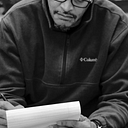The Storyteller Defines My…
In the beginning, few things incited us to hate. Our needs were few — the human touch, a warm meal and a sense of safety. Most would agree the universal depiction of this simplicity is a baby, humanity’s newest member.
The intriguing question is, “How does a baby grow up to become so angry and venomous to categorically hate?” The space between the baby and growing up is the collection of stories. These stories remind us of our daily threats, of fear and our need for control. It’s the stories that build reality.
The Story defines our Truths.
We have a history of stories driving our reality. A story is a sprinkle of facts and buckets of personal experiences, beliefs and hopes. A story can teach us, test us, entertain and scare us. Stories are events relived. We re-tell stories through our own lens. It’s not the event we believe in, it’s our interpretation of events based on a story from an imperfect source, us. That is our reality. If heard often enough, a story can create core beliefs or make us work against those same beliefs.
Since the time of Scribes and now the Press, events have been re-told and our responses to those events have been prescribed, or at least suggested.
Scribes used to document triumphant battles and stories of great romances. Scribes even told stories of daily living practices to secure a place in the here-after. The Press is our current day Scribes. The Press tells us what is newsworthy and distinguishes the good from the bad.
Now, we have social media. There is no singular morality. There is no longer a single reality. It is a mixture of celebrities, insightful personalities, humorists, hatemongers and idiots. There is no vetting. Everyone is telling a story over the megaphone.
What are the facts? What is the context? Where is the truth? Who’s truth? Are we being coned?
The Con, a subtle misdirection of context and facts by the storyteller, is not new. I’m sure the Scribes weren’t completely honest and surely the Press has succumbed to internal and external pressures. But now, as context and content become more individualized, we all repeat the Con.
Taxology of a Con
A con is a manipulated story that benefits the storyteller. Often enough, the storyteller infuses their beliefs, values and preferences using the story as cover. In essence, the storyteller guides you to an incontrovertible conclusion, imputing their personal experiences, beliefs, hopes and imagination over yours.
The con requires a willing participant (prey), someone needing affirmation, an opportunist or one that yearns affiliation. At the right time, any one of us can be duped. None of us are immune. We are human and we all desire connection. The prey needs to be weakened, whether hurt or have a compromised awareness, enough to suspend a healthy skepticism.
A con is a mixture of the right timing, an agreeable presentation, a plausible message and just enough facts mixed with a subtle misdirection. The concoction is a new truth; just right for being misguided. The longer the con, the more crippling and ruinous the outcome for the prey.
Can the con become a cult? Absolutely. It starts with the prey placed in self-preservation mode and later the likeminded become a protected society with its own culture and meaning; becoming worthy of defending, and to some extent, dying for.
The Story
Clearly, all stories aren’t fatal. Actually, some stories are embraced and are relied on as markers of time and rest. Stories and fables help us work through life’s complexities.
Let’s talk about Santa Claus as an example. We don’t know who the guy is, but we still tell our children the Christmas story and persuade them to be kind and obedient. On Christmas Eve, we say Santa Claus is coming down the chimney for milk and cookies in exchange for gifts. We’ve even come up with a back story with the elves and Mrs. Claus. Who would tell their child there was no Santa Claus with all the commercials and peer pressure in school? Side note: I didn’t have a chimney, so my parents were really exaggerating.
Another fable is the Tooth Fairy, a story designed to explain a traumatic event. We, nor our children, have the emotional vocabulary to explain the pain associated with human development, so we tell another story or fable.
Stories bury deep in our psyche and present in our society as truths. Sometimes it is too emotionally painful to challenge them. Some fables have become “truths,” like: Columbus discovering America, the love story of Pocahontas and the fidelity of Thomas Jefferson. Other widely believed fables are the absence of intellect in ancient Africa, the war on drugs, and the fairness in the justice system — just to name a few. Now juxtapose those fables with the more harmful stories like, the election was stolen or we are saving America from supporting the activity of immigrant human traffickers.
It’s confusing. What is more harmful? Some dispelled theory of a stolen election that built enough momentum to seize the Capitol or the revering of a mass murderer and an enslaver which supports the idea of race dominance? It’s tough, the storyteller controls the narrative. The storyteller controls the context. For generations to come the murderer could be the hero. We are America! We defend our heroes.
The Possibilities
What is the good news, you ask? We’ve all been conned together, and we are more aware than we were yesterday. It’s a shock to the system knowing we’ve been an ignorant participant in a massive charade. Can you be duped again? Of course. However, we have more information and directional awareness. What is the right direction? The knowledge that you can control your story. We have vastly more in common than not. And that we all started at the same point — needing only the human touch, the warmth of a meal and a sense of safety.
